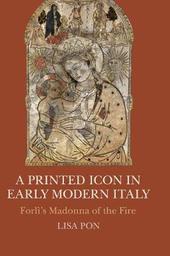
|
A Printed Icon in Early Modern Italy: Forli's Madonna of the Fire
Hardback
Main Details
| Title |
A Printed Icon in Early Modern Italy: Forli's Madonna of the Fire
|
| Authors and Contributors |
By (author) Lisa Pon
|
| Physical Properties |
| Format:Hardback | | Pages:310 | | Dimensions(mm): Height 257,Width 175 |
|
| Category/Genre | Renaissance art
Carvings
Religious subjects depicted in art |
|---|
| ISBN/Barcode |
9781107098510
|
| Classifications | Dewey:731.462 |
|---|
| Audience | | Tertiary Education (US: College) | |
|---|
| Illustrations |
4 Plates, color; 1 Maps; 61 Halftones, unspecified; 61 Halftones, black and white; 38 Line drawings, black and white
|
|
Publishing Details |
| Publisher |
Cambridge University Press
|
| Imprint |
Cambridge University Press
|
| Publication Date |
23 March 2015 |
| Publication Country |
United Kingdom
|
Description
In 1428, a devastating fire destroyed a schoolhouse in the northern Italian city of Forli, leaving only a woodcut of the Madonna and Child that had been tacked to the classroom wall. The people of Forli carried that print - now known as the Madonna of the Fire - into their cathedral, where two centuries later a new chapel was built to enshrine it. In this book, Lisa Pon considers a cascade of moments in the Madonna of the Fire's cultural biography: when ink was impressed onto paper at a now-unknown date; when that sheet was recognized by Forli's people as miraculous; when it was enshrined in various tabernacles and chapels in the cathedral; when it or one of its copies was - and still is - carried in procession. In doing so, Pon offers an experiment in art historical inquiry that spans more than three centuries of making, remaking, and renewal.
Author Biography
Lisa Pon is an associate professor in the Department of Art History at Southern Methodist University's Meadows School of the Arts, where she teaches the history of early modern European art, architecture, and visual culture. She has received research grants or fellowships from the American Council of Learned Societies, the Folger Shakespeare Library, the Gladys Krieble Delmas Foundation, the American Philosophical Society, the Center for the Advanced Study in the Visual Arts, the Getty Research Institute, and the Warburg Institute. She has published numerous articles in international academic journals and is author of Raphael, Durer, and Marcantonio Raimondi (2004) and coeditor of The Books of Venice/Il Libro Veneziano (2008, with Craig Kallendorf).
Reviews'Lisa Pon, one of the most distinguished historians of early prints, has given us a biography of the several 'lives' of a single image - a lone surviving impression of an anonymous early woodcut. Pon's exemplary case study deftly combines modern critical theory with deep historical sleuthing to elucidate the significance across the centuries of both Madonna of the Fire and its replications for Forli's religious and civic community alike.' Larry Silver, Farquhar Professor of Art History, University of Pennsylvania 'With imagination and wit, Lisa Pon tells the story of an unremarkable artifact's illustrious career. It is a telling tale about the complex relation of persons to things.' Joseph Leo Koerner, Harvard University, Massachusetts 'In A Printed Icon in Early Modern Italy, Lisa Pon excavates the cultural life of a singular and extraordinary object. Anchoring her study in a fifteenth-century Italian print that miraculously survived a fire, she expertly guides the reader through its placements and displacements over time and space.' Michael Gaudio, University of Minnesota 'A reading centered not only on the image, but on how it came to be used and the cultural heritage it helped generate ... a volume destined to be read and studied across the world.' Roberto Balzani, translation from SHARP News 'A volume destined to be read and studied across the world.' Il Resto del Carlino 'As a contribution to the history of Renaissance prints, Pon's unique microhistory of the Madonna del Fuoco situates the printed image in the rich context of miracle-working images in various media, modes of enshrinement and the culture of relics, civic pride and political rivalries, monuments, chronicles and festivals, and even the practices of Renaissance fire brigades.' Evelyn Lincoln, Art in Print
|